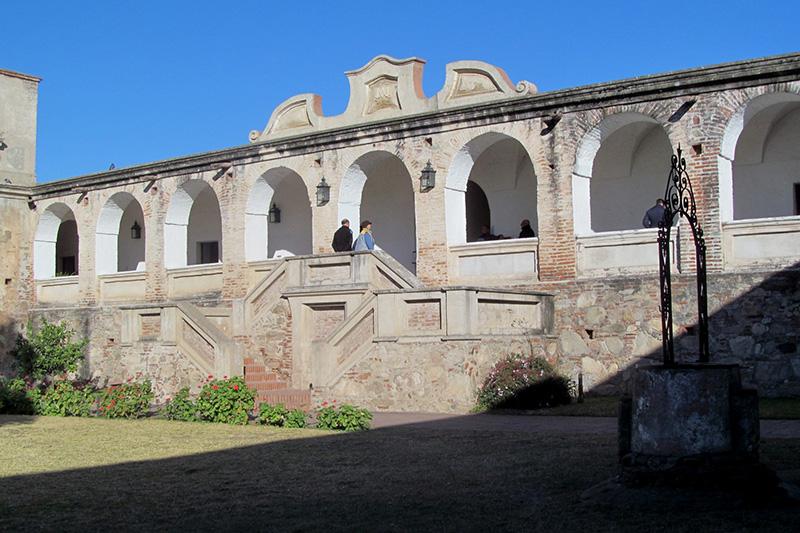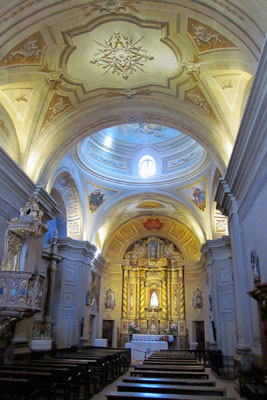Argentina - The estancia at Alta Gracia
This item appears on page 53 of the June 2015 issue.
(Second of two parts)
The Jesuits arrived in the New World in the late 16th century. In the newly founded city of Córdoba in north-central Argentina, they were granted a manzana, or land parcel, in 1599, where they built a complex that eventually included a church, a university, a residence for Jesuit priests and a collegium, or secondary school. To finance the complex, the Jesuits established large estancias, or ranches, in the countryside surrounding Córdoba.
These estancias each were large estates where farming, light manufacturing (often of textiles) and cattle-raising activities surrounded a central core that included a church, a priests’ residence and farmhouses for slaves and indigenous peoples. Slaves worked the land, usually for no wages, while the indigenous population often included artisans who were paid wages.
These rural estancias provided the funds for the Jesuit church and educational institutions in the city of Córdoba. This arrangement was to endure for 150 years until the Jesuits were expelled from Spanish America in 1767 by order of King Charles III of Spain. They were seen as a threat to royal power, particularly politically.
Visit to an estancia
Having visited the UNESCO World Heritage Site of the Manzana in Córdoba (May ’15, pg. 55), my husband, Paul, and I wanted to tour one of the Jesuit estancias as well. We selected Alta Gracia because, among the five major estancias near Córdoba, it was the closest, located just 22 miles southwest of the city.
Alta Gracia began as part of a land grant given in 1588 to Juan Nieto, one of the founders of Córdoba. After his death, his widow married Alonso Nieto de Herrara. When she died, he entered the Jesuit order in 1643 and donated the lands inherited from his wife to the Jesuits. Alta Gracia remained with the Jesuits for 124 years until their expulsion.
Afterward, it passed into the hands of a number of wealthy families: Rodríguez, Liniers, Solares and Lozada. The last family, the Lozadas, owned the property for a century, from 1868 to 1968, when it was expropriated by the Argentinian government.
Alta Gracia is a beautiful property, and it was especially so on the mild, sunny afternoon that we visited in August 2014 (late wintertime in Argentina).
A high wall with an elaborate gateway leads into a large patio surrounded on two sides by a residence that was the Jesuit priests’ house in the 17th and 18th centuries and, later, the mansion of the families who lived there for the next 200 years.
On the fourth side is the church, with a Baroque façade and an espadaña, or bell gable, on the east end.
The estancia-museum
The L-shaped residence at Alta Gracia is now a museum. On the ground floor are storerooms dating from when the Jesuits lived there in the 17th and 18th centuries. On the floor above are rooms decorated in the varying styles of the occupants who lived there after the Jesuits left.
There’s a reception room looking much as it must have when Viceroy Santiago de Liniers lived there early in the 19th century, with a kitchen and pantry added to the house at about the same time (the Jesuits apparently did their cooking in a nearby thatch-roofed building), not to mention a dining room as well as bedrooms both austere and grand.
These rooms are filled with the possessions of these families: religious statues and paintings, portraits, a leather chest belonging to the Liniers family, Manuel Solares’ bookcase, an entire bedroom set of the Lozadas’ dominated by a German baroque-style bed, and a late-19th-century Lozada dining room with an impressive, massive oak sideboard with caryatids.
The church the Jesuits built in the 17th century occupies the south side of the patio. At the east end of the ornate church interior is a resplendent altarpiece. As in the Jesuit Church that is part of the Córdoba Manzana, the Jesuits usually decorated their churches lavishly.
Both sides of a coin
Visiting Alta Gracia is like seeing the other side of the coin. If possible, you need to visit both Córdoba’s Manzana and at least one of the Jesuit estancias to understand the unique religious, social and economic experiment that occurred there in the 17th and 18th centuries.
Córdoba’s Manzana and its outlying estancias were self-sufficient worlds unto themselves, each complementing the other. This occurred also in Jesuit establishments elsewhere in Argentina and in Brazil and Paraguay.
Our only regret was that we didn’t have enough time to visit some of the other major Jesuit estancias near Córdoba: Caroya, Jesús Maria, Santa Catalina and La Candelaria.
Home of Che Guevara
Alta Gracia, which is also the name of the town where the Jesuit estancia is located, is the site of the large villa where the revolutionary Ernesto “Che” Guevara grew up. His family moved there in 1932 when Che was four years old because the climate was beneficial to the young Che, who had asthma.
The house is filled with memorabilia, including Che’s bicycle, typewriter and uniform plus photos of Che from childhood to adulthood. Some show him with a young Fidel Castro in the early days of the Cuban Revolution.
The Casa del Che (phone 03547 428 579) is located at 501 Avellaneda and is open 2 to 6:30 Monday and 9 to 6:30 Tuesday to Sunday. The entrance fee is a hefty 75 pesos, or about $8.50.
If you go…
For our day excursion to Alta Gracia, we asked the Azur Real, the excellent boutique hotel where we were staying, to arrange a car and driver. A guide was not necessary. The cost, not including a lunch stop or the tip, was $167.
The Alta Gracia estancia (phone 03547 421 303, www.altagracia.gov.ar [in Spanish only]) is located at 41 Avenida Padre Viera.
Check the website for the hours it’s open (which vary considerably depending on the week and season) and for times of the guided tours, although you can tour on your own as we did. The entrance fee is 20 pesos, or $2.25.


